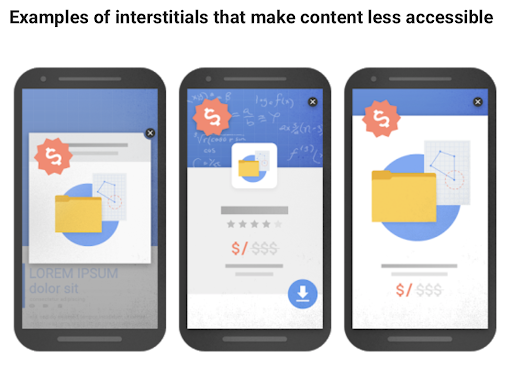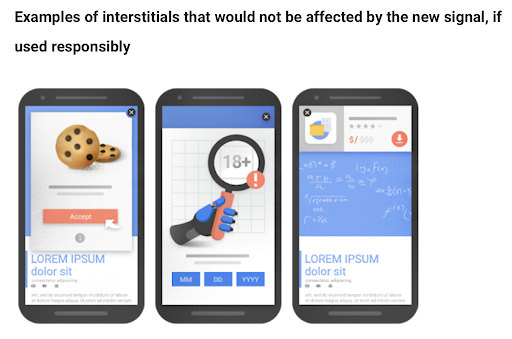30-second summary:
- Google page experience metric goes live in 2021.
- Rewarding pages that offer a better user experience.
- The signal measures a site’s performance, security, and mobile-friendliness.
- To prepare for 2021, get a fast web hosting service, optimize your content for mobile users, and install security measures (firewall, SSL, etc.).
- Avoid pop-ups and whole screen banners that restrict the visitors’ access to content.
The newest search ranking benchmark that’s cooking in Google’s development lab is the Google page experience metric.
In short, this upcoming metric aims to measure (and rank) the overall responsiveness and user experience of websites that show up in Google’s search results.
Google plans to introduce this metric alongside the current ranking factors. However, there isn’t an exact date announced when this metric goes live.
As Google’s developers officially state in their blog:
“The ranking changes [Google page experience] described in this post will not happen before next year [2021], and we will provide at least six months notice before they’re rolled out.”
You still have plenty of time to react. However, we suggest planning ahead and implementing some of the best practices as soon as possible.
Let’s take a look at what you can expect from this ranking update and how you can prepare your site from the Search Engine Optimization (SEO) perspective.
Elements of the Google page experience metric
Google is mainly building the new metric upon the Core Web Vitals that their Chrome team launched earlier this year.
The overall goal with Google’s page experience metric is to ensure the Google Search users are getting a mobile-friendly, safe, and straightforward browsing experience.
Let’s look at each element that contributes to the page experience metric.
1. Core Web Vitals
Google developed the Core Web Vitals because the average user enjoys fast and seamless web surfing. They also created a Chrome User Experience Report, which you can use to evaluate your site’s current performance according to these signals.

The Core Web Vitals consist of three separate signals:
- Largest Contentful Paint (LCP) – quickness of the largest content piece’s loading time.
- First Input Delay (FID) – responsiveness to the user’s clicking, scrolling, and typing.
- Cumulative Layout Shift (CLS) – visual stability of the page.
To tick a box in each of these signals, your pages’ LCP should be below 2.5 seconds, FID below 100ms and the CLS score less than 0.1.
2. Mobile-friendly site
Google already favors sites that are optimized for mobile users, and rightfully so.
Research conducted by Statista reveals that there are an estimated 3.5 billion smartphone users this year, with this number growing to 3.8 billion in 2021. It’s safe to say that sites that aren’t mobile-optimized will miss a lot of traffic.
Therefore, it makes sense that Google only wants their search to display mobile-friendly sites.
3. Safe-browsing
Google puts a lot of emphasis on security and weeding out potentially harmful sites from their search results. After all, if the top search results harm users, it won’t look good on Google at all.
One of the signals with the upcoming page experience metric concludes if the indexed site contains any malicious or deceptive content. Some straightforward examples are malware, spyware, social engineering scams, and false information.
To get a sense of how this works, check out Google’s Security Issues report. You can also scan your website to see if any issues pop up at this time.
4. HTTPS
Following the security topic, Google also prefers secure sites with a Secure Sockets Layer (SSL) certificate. Visibly, the difference is between http:// and https:// (where the latter is SSL secured) in the website’s URL.
The SSL certificate’s job is to encrypt any data that travels between the user and the servers. Even if a cyber attack occurs, the hackers are unlikely to make sense of the data.
If you’ve used the Chrome browser, then you might have come across a security warning with a suggestion that the connection is not secure. This is mainly due to the site missing an SSL certificate.

5. No intrusive interstitials
Last but not least, Google aims to punish sites that aggressively keep the visitors away from quickly accessing the content they are looking for in the first place.
The main culprits here are the pop-ups that cover the entire screen, are difficult to dismiss, or keep popping up while consuming the content.
However, disclaimers, cookie usage information, age-sensitive content confirmations, login dialogs, and reasonably sized banners aren’t going to affect your ranking.

Five steps to optimize your site for 2021
Google’s new page experience metric isn’t going to substitute the current ranking elements. It becomes an additional ranking factor, but the most essential part from an SEO perspective is still the quality of the content.
Still, since the page experience metric IS going to affect the ranking results, it’s a great idea to know what you can do to prepare.
Here are a few steps you can take to get your site ready for 2021.
1. Get an excellent web hosting service
Your site’s performance is already one of the key ranking factors today. Either you have a server in-house or using a hosting service, it’s wise to make sure your site is fast and responsive.
You can analyze your site’s responsiveness with Google’s PageSpeed Insights tool or use a website performance monitoring tool such as Pingdom.
Additionally, you can check out sites that gather and share performance data on web hosting providers.

2. Keep your page’s size lite
Images go hand-in-hand with today’s websites. However, overstuffing your web pages with visual content is going to make your site slow.
There are a few ways to approach this problem, depending on the nature of your site.
You can optimize your images and make them weigh less by using an image compressor such as ImageOptim. If your page is already content-heavy, consider spreading the largest items to multiple pages within your site.
Alternatively, you can use a Content Delivery Network (CDN) such as CloudFlare to cache your content closer to the visitor’s access point.
3. Optimize your site for mobile
As we proved earlier, the world is heading rapidly to mobile. It’s not enough for your users to access your content with their smartphones; they also expect your site to adjust to the smaller screens.
Therefore, your site needs to be mobile-optimized.
The good news is that most modern website creation platforms, such as WordPress, already have mobile-friendly templates that don’t require extra coding efforts.
You can quickly test if your site is mobile-responsive by using Google’s Mobile-Friendly testing tool.
4. Install security measures
Website security definitely deserves a separate article to cover all the bases, but let’s only focus on Google’s perspective.
First, don’t knowingly add any malicious scripts or deceptive content to your website.
Secondly, protect your site from malware and other hacking attempts by adding a firewall. While it’s not clear yet if Google will check your site for a firewall, you should have one in place either way.
And finally, install an SSL certificate that encrypts your data since Google is already keeping tabs on if a site is secure or not. However, most of the modern hosting services already include an SSL certificate with their plans.
Overall, investing in website security is worth it for peace of mind and from the SEO perspective.
5. Tone down or remove large pop-up banners
Google considers anything that keeps its users from accessing the content they search for as a nuisance.
Therefore, a piece of straightforward advice – don’t put a giant banner on your site. Make the promotion more subtle, and you won’t have any problems with Google.
As a reminder, cookie information, age-restriction policies, and login dialogs are the exceptions. Although, please don’t go overboard with these either for the sake of user experience.

In conclusion
Google’s page experience metric will become one of the search ranking signals in 2021, but there isn’t an exact launch date yet.
Still, you can start preparing your site for the upcoming changes. Even if it’s unclear how much weight this new metric has on the search results, offering your visitors a great user experience is a substantial value on its own.
Start by testing your site’s performance, security, and mobile-friendliness. The results give you a pretty good idea of what to tweak and add to your site.
However, remember that the most important ranking factor is still the quality of the content.
Gert Svaiko is a professional copywriter and mainly works with digital marketing companies in the US and EU. You can reach him on LinkedIn.
The post The Google page experience: What you need to know and five steps to prepare for 2021 appeared first on Search Engine Watch.
No comments:
Post a Comment